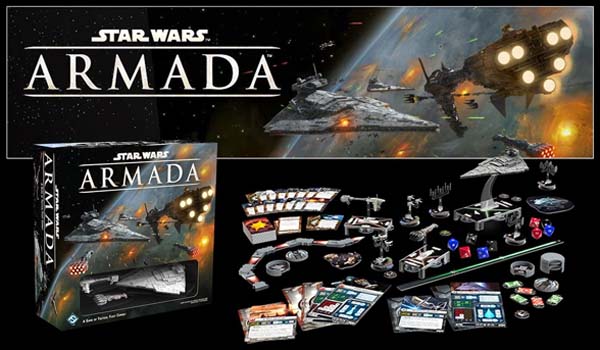
If you like the Star Wars: X-Wing miniatures game (and I do like it), or if you're eagerly awaiting the release of the second edition, but you don't want to house-rule that your car can act as a makeshift Star Destroyer, then Fantasy Flight has you covered. Star Wars: Armada is a higher-scale, tactical combat game using capital ships, and it might actually be a considerably better game than the core X-Wing set (at least better than the first edition)!
Planning ahead
Much like the board game Sails of Glory (which I also really like), Armada requires you to plan the actions of your capital ships a couple turns in advance. However, unlike Sails of Glory, it isn't the movement of these ships that you must pre-plan; it's their desired "commands". I was a little disappointed that the capital ships don't require that players plan their movement in advance, but then again, the maneuverability of these ships is highly limited, and only gets lower as the ship goes faster (if the ship in question even can go faster). There is a sense of inertia to these behemoth ships, but not quite the same level of inertia as the sailing ships of Sails of Glory.
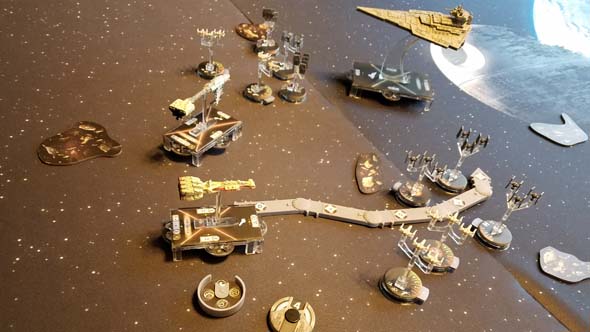
Ships move very slowly and have very limited maneuverability.
I do like that these ships both begin and end their movement relative to the font of their base. This alleviates the problems that X-Wing had with its large ships counter-intuitively moving faster than their smaller counterparts. And since the base Armada package comes with ships of varying sizes, this improvement is immediately noticeable without needing to wait for expansions: all ships move and turn at consistent speeds.
The rules do require that ships attack prior to moving. This means that you must plan ahead a little bit, since you have to position yourself for an attack in the turn prior, and have to anticipate who will have initiative and where their ship(s) will be if they get to move them before you get to make your attack.
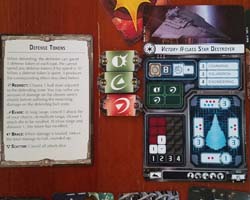
Defense tokens give players
more meaningful decisions.
More meaningful decisions
Even defense is a tactical decision! And this might be the single, best change from X-Wing. Instead of simply rolling defense dice to cancel out your opponent's attack rolls, you get to chose a set of defense tokens to apply, and each one mitigates damage in different ways. One defense token may allow you to cancel out an opponent's die roll, while another will allow you to redirect the damage to another hull section's shields, and yet another halves the total damage dealt. These tokens refresh each round, unless you use twice in the same round, in which case, it is permanently discarded.
This alleviates another of the problems that permeated X-Wing: that damaging an opponent often felt like playing craps. Getting into perfect position and lining up a point-blank shot against an opponent can be completely foiled by dice rolls in X-Wing. Dice still play a role in Armada, but damage seems to be much more consistently-dealt, and players actually have a say in how their ships defend themselves from damage. It gives the player more meaningful decisions.
The Pilot Skill mechanic was also scrapped. You get to decide in which order you want to activate your ships in each round (for both ships and squadrons), and players simply alternate between activating a ship of their choice. This makes it harder to judge whether the space that you're planning on moving into will be occupied, but it means that you get to strategically prioritize your movements, attacks, and defense. If a ship is critically damaged, you can chose to activate it early in order to try to get one last action before it goes kabloom. Initiative is still determined by who has the smaller fleet size, so you'll know who gets to act first (even though you don't know which ship or squadron they'll activate) before committing a ship to a possible suicide run.
Pretty - but sometimes fiddly- components
One way that this game kind of fumbles a bit compared to X-Wing is with the amount of manual dexterity it requires. X-Wing has some risk of accidentally touching and displacing the ships when trying to maneuver or test range or line of sight, but it's only a minor problem. Armada has these same problems, but the maneuver tool also makes moving ships in tight quarters (without accidentally screwing up other nearby ships) more difficult. The ship bases rest on four feet that elevate the base a little bit above the playing surface. You'd think that this would be intended to allow other components (such as the maneuver tool or range ruler) to be able to slide underneath. But the plastic hook that slots the ship stand into the base sticks out below and mostly defeats this purpose.
Adjusting shield dials and trying to position the maneuver tool often results in displacing other ships on the board.
Having dials on the ship and squadron bases that have to be frequently adjusted compounds the issue and makes it very difficult - almost impossible - to avoid accidentally displacing the ships a little (especially the squadrons). The upside to these dials is that they provide more information about the state of the game that can be viewed at a glance in the play area. You don't have to crane your neck to look at your opponent's cards on the other side of the table. And besides, it's a miniatures game, so accidentally displacing the miniatures during the course of play is par for the course. Can't blame Fantasy Flight for failing to solve an intractable problem within the genre.
More structured play and consistent game lengths
On the other hand, there are some actual mechanics that I'm personally conflicted about. One such mechanic is the turn-timer. The game has a limit of six rounds before it arbitrarily ends. On the one hand, this keeps the length of games more consistent, and it prevents one player from dragging out a game by playing keep-away for hours. It also acts as a bit of a balancing mechanic by preventing the rebel player from destroying the Empire's TIE Fighters and then using its X-Wings to slowly paper-cut the Star Destroyer to death.
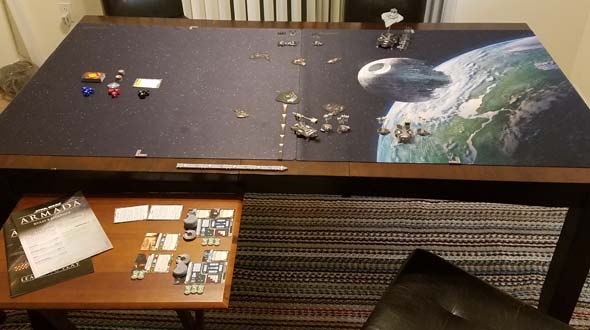
The learning scenario is on a 3' x 3' board, but a regulation play area is 3' x 6'.
The downside is that even games that are played "correctly" (i.e. without cheesey keep-away tactics) can often seem like they end prematurely. If you don't bum rush each other, half the game can feel like it's just moving the ships into range and position to attack each other. Then each player gets two or three rounds of shooting, and the game is over. That's not much time to make tactical decisions or meticulously put your ships in position for a devastating attack, which sadly undercuts the fact that this game genuinely has more meaningful decisions for the player to make on a turn-to-turn basis. Further, if neither side is able to put their ships in a position to focus-fire a single target with both of their ship's attacks in a single round, then it's exceedingly unlikely that any ships will be destroyed.
In deathmatch games, players can just agree to ignore the turn timer, as its main function seems to be to compliment the game's objectives. This game has a greater focus on objective-based matches than its dogfighting predecessor (which did have optional scenarios and objectives, but I pretty much ignored them). The set comes packaged with a small deck of objective cards that modify certain game rules and impose a set of objectives, goals, or extra sources of victory points for the players to compete over.
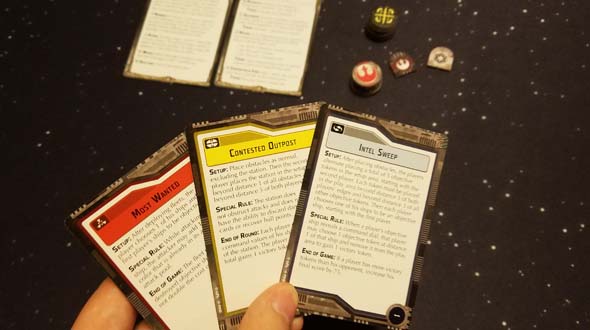
The turn limit may be designed to pressure players into completing objectives.
The greater emphasis on mission and objective-based play is a bit of a double-edged sword. On the one hand, the objectives make the game feel much more structured and purposeful, and provide for some interesting and challenging strategic situations. The turn timer encourages players to focus on a single target and achieve objectives. On the other hand, the long-term viability of the game depends on the variety of objectives available. There's a decent number included, but they may not all be compelling to every player.
Fortunately these are objectives and not scenarios, so they don't necessarily have a pre-defined setup or configuration. They still allow for full freedom in fleet-building, and other than some variant rules for setup, they allow for freedom deployment. You're not replaying the exact same set-up every time. In fact, there's actually no scenarios included in this set at all, which is weird because I would have thought that the turn limit and focus on structure play would have given even more reason to give context to the battles. If Fantasy Flight does not provide any new objectives or scenarios in expansions, then it is possible that the selection in the core package may eventually become stale.
Seriously, Fantasy Flight still didn't pack enough dice?!
There's only six turn tokens in the box, so if you want to go longer, you'll have to find a different way to mark the turns. If more tokens were included, or if the provided tokens were double-sided and counted to a higher number, then players could easily just set the turn limit higher if they want. This would also allow for custom scenarios to be designed to last longer than the default six rounds. Even in deathmatch skirmishes, the turn limit still has value, so I don't want to discard the mechanic entirely. I feel like the box should at least support up to 8 or 10 turns, or have objectives in which the turn timer doesn't start until the first shot's been fired (thus providing 6 full rounds of combat).
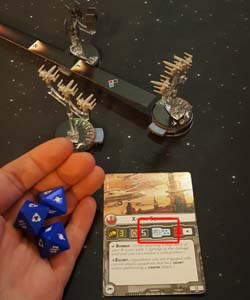
X-Wing squadrons have more attack
dice than are in the package.
On the topic of component limitations, there's not enough blue dice in the box. There's three of each black, blue, and red dice (to represent different attack types and ranges). However, the X-Wing squadrons have a base, un-modified, attack of four blue dice against other squadrons. Why couldn't Fantasy Flight just pack a fourth blue die in the box so there's enough components to actually play the game? X-Wing had a similar problem with close and long-range attacks adding extra attack or defense dice (respectively), and requiring more dice than are in the base package. But in Armada, you don't even need to modify the X-Wing's base attack to not have enough dice; this is the value that is printed on their stat card! It seems like a cheap way to try to get players to shell out another $12 for extra dice. And no, the dice are not the same as the X-Wing dice, so you can't simply combine the dice from that package.
Other than the shortage of dice, the components are (as is standard for Fantasy Flight) top-notch. Much like with X-Wing, the ship models here are display-quality. When you're not playing the game, they're pretty enough to be set on a shelf, mantle, or curio cabinet, instead of being concealed away in a box. The fighter squadrons are unpainted, but are surprisingly well-sculpted and detailed for their size. They're also pretty sturdy. Even though the plastic is very thin, they have enough give that they don't snap, but are also rigid enough to maintain their shape and look nice after repeat plays.
Learning lssons from X-Wing
Most of my friends seem to prefer the simplicity and familiarity of X-Wing, so I haven't gotten as many opportunities to play Armada over the few years since it's release. It's a shame, because I think I like this game more than I like X-Wing. I feel like Fantasy Flight learned some good lessons from X-Wing, and that my turn-to-turn decisions matter more. Of course, I'll have to see how Armada holds up with expansions (I own some, but haven't played with them yet).
Objectives like "Hyperspace Assault" create some interesting and challenging strategic situations,
and require some rules clarifications.
The game feels a little bit more like Sails of Glory than like X-Wing. Each game does some things better than the other. Sails of Glory has the advantage of the highly flexible ruleset that makes it a much more accessible game, but Armada definitely gets the overall edge due to the exceptionally high quality of its components, the greater versatility in fleet and ship builds, and overall smoother play. Fantasy Flight always puts a lot of production value into its games, and it's no wonder that Armada is one of the company's premiere products!
Of course, you'll have to pay for this production quality. This game retails at $100 (USD)! That makes it one of the most expensive retail board games out there. It's good, but it's pricey.
PROS
- Very nice, detailed, collectible-quality plastic miniatures!
- Ship models being suspended above their bases makes measuring line-of-sight easier
- Requires careful thought on both offense and defense
- Fixes some of my movement complaints from X-Wing
- Most of the game state is represented in the play area
- Objectives provides more structured play
- Turn limit prevents games from dragging on
CONS
- Having to adjust dials on the ship bases increases risk of displacing the ships
- Turn limit leads to many games ending prematurely
- Not enough dice to resolve base X-Wing squadron attacks
- Very expensive retail price
FINAL GRADE: A-
Manufacturer: Fantasy Flight
Lead Designers: James Kniffen and Christian T. Petersen
Original release: April 22, 2015
MSRP: $99.95 USD
Player(s): 2-players
Game Length: 2 hours
Official site: fantasyflightgames.com/en/products/star-wars-armada/